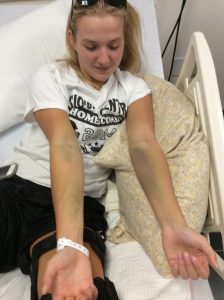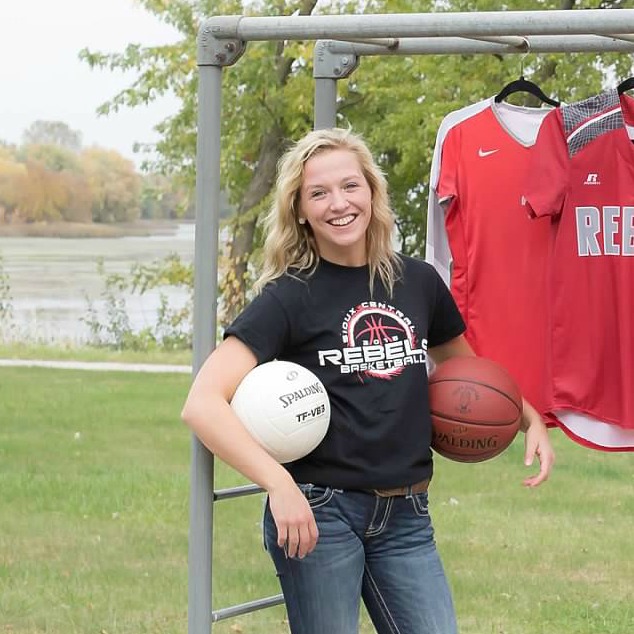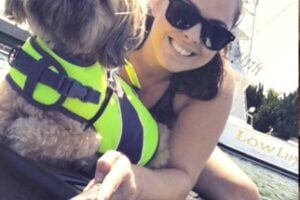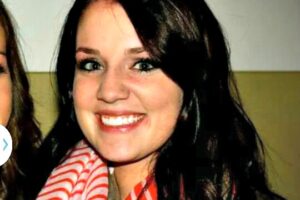I always love to hear the stories of how people beat cancer and overcame diseases, but I never thought anything bad would happen to me. My name is Jenny, and I am a 17-year-old girl who lives in a small town in Iowa. In my high school, I am involved in many activities, including softball, volleyball, basketball, track, large group speech, band, jazz band, choir, and the Future Farmers Association, along with many other clubs. Let’s just say I was a very involved girl and always busy, until my life started to slow down. On July 7, 2015, during a volleyball camp, I came down on my left leg and tore my ACL and meniscus. I was 16 years old when this happened and I thought tearing my knee up was the worst thing that ever happened to me, because I could not play softball, volleyball, and half a season of basketball.
My parents, Trent and Jill, scheduled my surgery for July 21, and everything went smoothly. I came home that same day and went to physical therapy for the next couple of days. Everything was looking good, the swelling was going down, and I was off pain meds four days after surgery. I felt good, and we had to cut the straps to make my brace tighter around my knee because the swelling had gone down so much. Then I started not to feel good. I felt very sick and just did not want to get up or do anything, which was very unusual for me. I laid on the couch all day until my mom and I went to the chiropractor, because I thought my hips were out. When I was lying on the table, we realized that my whole left leg was double the size as my other leg. My mom, being the detective that she is, looked up my symptoms on Google and this was when I was introduced to DVTs. My pain was so unbearable that we decided to go to our local emergency room at 7:00 in the morning on Friday.
Doctors performed an ultrasound and diagnosed me with a blood clot in my left leg. They sent me home with a heparin shot and told me to come back the next day. I did not last through the night. I was in so much pain that my mom, dad, nor I got any sleep that night. I went to the same E.R. at 4:00 in the morning on Saturday. We had no idea how big the blood clot was, other than from my ankle to the very top of my leg. I had pain in my tummy and the E.R. doctors thought my appendix ruptured. I had a CT scan in the morning showing that my appendix did not rupture, and the doctors said I was probably constipated from the medicines of my surgery. I got admitted to the hospital at noon that day for pain control. That is when my family doctor sent a report of my case to a bigger hospital, located in Sioux City, Iowa, where they wanted to see me right away.
 When I arrived in Sioux City, I was in their E.R., and then I visited with an interventional radiologist, who diagnosed my blood clot all the way up in to my groin, which resulted in the stomach pain I was experiencing. I had an inferior vena cava filter placed, and a catheter was inserted down my leg to allow for the clot busting medication tPA to drip in my leg. This can be a very dangerous drip, and is use on some stroke patients, but it was the quickest way to dissolve my clot, which was building very quickly. The doctor could not push it down my leg because the clots were so thick. The doctor did finally get the tPA to my knee, and I was admitted to the ICU. I do not remember much about that day, except getting poked for many IVs and getting my blood checked every few hours. The next day, we visited the interventional radiologist once again, and he could push the tube down the rest of my leg. I loved how he showed me everything he was doing on the screen. He was one of my favorite doctors through this process.
When I arrived in Sioux City, I was in their E.R., and then I visited with an interventional radiologist, who diagnosed my blood clot all the way up in to my groin, which resulted in the stomach pain I was experiencing. I had an inferior vena cava filter placed, and a catheter was inserted down my leg to allow for the clot busting medication tPA to drip in my leg. This can be a very dangerous drip, and is use on some stroke patients, but it was the quickest way to dissolve my clot, which was building very quickly. The doctor could not push it down my leg because the clots were so thick. The doctor did finally get the tPA to my knee, and I was admitted to the ICU. I do not remember much about that day, except getting poked for many IVs and getting my blood checked every few hours. The next day, we visited the interventional radiologist once again, and he could push the tube down the rest of my leg. I loved how he showed me everything he was doing on the screen. He was one of my favorite doctors through this process.
After four days of being in the ICU with many IVs in my bruised arms, a catheter, and many blood checks, my blood clot started to dissolve. I finally felt amazing – I had to lay in that bed for four straight days without sitting up – when I got up to walk around on my crutches, which was painful, as I had an IV in my hand. I was transferred to the pediatric floor as I was still under 18 years old, and all I wanted to do was go home, so I could make it to my cousin’s wedding. I had such a great support group, and I had many visitors, even though I was not able to communicate very well or stay awake for long. I finally got to leave the day before my cousin’s wedding, which was on August 7. The next problem was that the hematologist did not want to follow up with me, because I was a pediatric patient. I was sent home on warfarin, and I had to get my INR checked every few days in the doctor’s office.
My mom being the detective again was researching online and knew that getting a blood clot after knee surgery is common, but not the kind of blood clot I had and to extent that I had it. We eventually ended up going to the Mayo Clinic, where I was paired up with a hematologist who thought inactivity due to my knee surgery was the cause of my blood clot. Since I had no personal or family history of blood clots, she thought not being active was the cause of it. She also did a blood test to test for every blood disorder, and I was diagnosed with low antithrombin.
Antithrombin is a protein in everyone’s blood that prevents your blood from clotting too much. It is kind of like a natural blood thinner in that regard. My doctor told me that the normal base for antithrombin is around 80-100, and my number was 40. Only one person out of every 100,000 to 300,000 are diagnosed with this type of clotting disorder. We finally had an answer for why I had a blood clot, and it lowered anxiety a little bit for both me and my mom. We could both finally sleep at night knowing what happened, and knowing what to do if it ever happened again.
I am halfway through my senior year of high school. My athletic career just recently ended, as I tore my right ACL, medical meniscus, and my lateral meniscus. I am so scared that I am going to have to go through this whole process again, but I am very lucky we found out that I have low antithrombin. Before the surgery, we are meeting with my hematologist to explain what steps I need to take after my surgery so I do not have to go through the hardest time of my life again.
I do not think I could have done with the support from my family, friends, and boyfriend. They made this all easier and reminded me of how strong I really am. I just remember thinking that it could be so much worse, and I put my thoughts and prayers out to everyone who must fight any disease, sickness, or surgery. These survivor stories have inspired me to share mine, and I loved reading them after my blood clot. I hope that I can help someone in the future. Just remember that you can get through it, and I will be praying for you.




